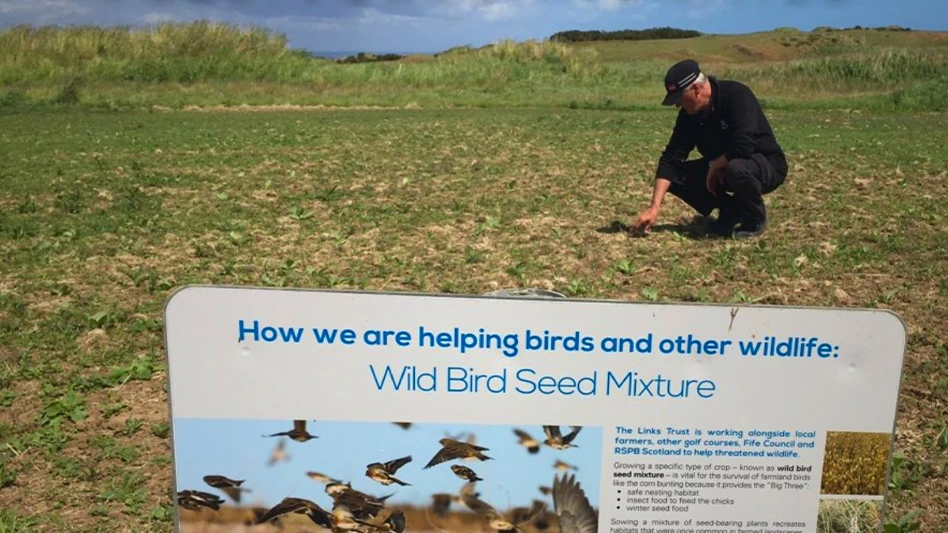 Landscapes Unlimited built two distinct 18-hole courses in five months, overcoming sandy soils, high winds and a remote location to create a destination for golf purists.
Landscapes Unlimited built two distinct 18-hole courses in five months, overcoming sandy soils, high winds and a remote location to create a destination for golf purists.
So begins the tale of two courses: so different, in fact, that the builder, Landscapes Unlimited, treated them as two different projects, even though they were being built simultaneously in the same area. As different as they were, perhaps the most amazing feat was that they were built in five months.
"Ideally, to build a course in most parts of the U.S., it would take us six to 12 months, so given that we were on a five-month schedule, the architects, contractors, developers and everyone else had to be focused to stay on schedule," says Bill Kubly, CEO and founder of Landscapes Unlimited.
The land each course was built on was vastly distinct. The Dunes Course, designed by Tom Lehman and Chris Brands, had a lot of natural features that didn't require much shaping other than bunker work. It was simply routed through the existing sand dunes and left to be a natural, links-style course.
 Though full of dramatic views, the Pines Course also provided plenty of challenges for building, thanks to its remoteness in the sand hills of Nebraska. Though full of dramatic views, the Pines Course also provided plenty of challenges for building, thanks to its remoteness in the sand hills of Nebraska. |
The Pines Course, designed by Graham Marsh, had some sand dunes as well but also featured plenty of pine trees and dramatic bluffs, which is unique to the sand hills area of Nebraska.
"Both courses are very dramatic," says Kubly. "They're different, but they blend well together and make for a great golfing experience."
One of the major challenges of the site was its remoteness. Kubly says they were literally in the "middle of nowhere," and that presented many problems, one of which was the acquisition of labor.
"When you get into these remote parts of the U.S., the ranchland, there is no labor available, even with the high unemployment rate," he says.
Lucky for him, however, his company was familiar with the H2B temporary worker program, where companies can secure workers from Mexico who are then allowed to work in the U.S. for eight months, then must go home for the remaining four months. Landscapes Unlimited has had as many as 450 H2B workers at one time, and for its Sutton Bay project in South Dakota used 40 workers for construction and 18 for existing maintenance.
"It has been a godsend to have these workers from Mexico that we're so dependent on for the projects that we can get certified for H2B," Kubly says. "It's not doable for a lot of projects because the unemployment rate is so high, the government won't allow us to bring these workers in and makes us use local labor instead."
Club management was educated in all aspects of the H2B program including labor certification, employee recruitment and program compliance requirements. H2B employees interested in accepting employment as maintenance staff were assigned to project construction crews. This resulted in a "built-in" recruitment pool from which the superintendent would select and hire maintenance staff.
"The continuity created by transferring construction staff to maintenance staff allowed for a seamless transition of the course from contractor to owner," says Kubly.
Due to the remoteness of the site, off-site lodging for these employees was unavailable, so most of an entire hotel was rented out for the duration of the project.
"We met with the proprietors early in the project to discuss our needs, and they were terrific to work with, even going as far as to provide our crews with special bilingual needs," says Kubly.
The remoteness of the site also provided some challenges as far as getting power to the site. Three-phase power was not available for the wells and pump station to meet the grassing timeframe, so generators were used during the maturation and grow-in of the courses until the town of Valentine was able to bring in three-phase power.
"This required daily maintenance and operation of this critical component," Kubly says.
High winds also didn't make for a picnic on this extensive and fast-paced project.
"When you're building things out of pure sand, the wind can come up and destroy what you've done that day, but mainly when it comes to grassing the course, there are a lot of days when it's so windy, if you try to seed it just blows all over the place," says Kubly. "If you're trying to plant different types of grasses on greens, for instance, you may have to wait two to three to four days before you can actually plant that seed. There's a lot of wind erosion."
Kubly says they didn't use much hydroseeding or erosion blankets to combat the problem. As far as the blankets are concerned, he says the site was so vast they wouldn't have known where to start and stop them.
"The key was keeping the ground wet once you had the seed down, and then you probably had a six- to 10-day window to get the seed sprouted to hold the sand itself," he says. "On most courses, you would have only had the potential for that problem on the greens, but in this case, the whole course was built the same way. The same sand material that was in the greens and bunkers was also in the fairways and rough."
 The wind also created problems with the irrigation system, says Rob Christie, who worked as construction superintendent on the site.
The wind also created problems with the irrigation system, says Rob Christie, who worked as construction superintendent on the site.
"The wind blew a lot of sand in the irrigation pond, and it was so fine that it got into the irrigation system and caused some heads to stick on," says Christie.
Christie says the number-one problem in his opinion was clearing the prairie grass on the Dunes Course.
"Usually when you're shaping in you're destroying everything and coming back with clean dirt, but we weren't doing a lot of shaping," he says. "We were originally going to seed right into it but it just wasn't seedable. The root system was pretty intense, and when we went in there to till it up, it just brought up the roots so it turned into quite an ordeal."
Weather can often be a nemesis of a golf course construction project, causing massive delays. But that was at least one challenge those involved with The Prairie Club project were able to avoid. It's for that reason that Christie would not classify the project as one of the hardest he has worked on.
"Every project seems to have its own unique challenges," says Christie, "but on this one we didn't have a lot of rain days or weather challenges. We had a couple thunderstorms but that was it. On our end, everything went pretty smoothly."
As far as difficulty, Kubly ranks Prairie Club in the top 10 percent of the 400 to 500 courses Landscapes Unlimited has built. But he says there were aspects of it that were easy, too.
"As difficult as parts of the job were, a lot of it was simpler," he says. "For example, we had none of the bureaucracy that you would encounter in some major U.S. cities in regard to wetland and erosion control. Since we were in the middle of nowhere, there were not nearly as many regulations."
One of the unique aspects of the project in Kubly's mind was the fact that it proved people are still spending money to develop remote golf courses even in tough economic times.
"At a time like this, people wonder how could a course work economically," he says. "But this developer had the guts to do it and proved, by picking two top architects, that he has a project out there that is very successful. It puts little old Nebraska on the map as a great place for golf, and when you look at the three world-class courses there now in Sand Hills, Dismal River and now Prairie Club, who would ever have thought it would become one of the top golf meccas in the world?"
Accolades the course has already gotten include "Best New Course" in the world and "Overnight Destination of the Year" by Golf Digest, "Best New Courses of 2010" for the Dunes Course (#2) and "Best New Courses of 2010) for the Pines Course (#8) by Golf Magazine, and "Top 10 New Golf Destinations in the World" by Links magazine.
If those honors didn't get golfers' attention, then certainly the publicity campaign that owner Paul Schock spearheaded did.
In addition to creating a Facebook page and a posting a viral video on YouTube, the campaign netted more than 85 articles which generated more than 25.6 million impressions among serious golfers worldwide.

Explore the September 2011 Issue
Check out more from this issue and find your next story to read.
Latest from Golf Course Industry
- Making the grade — at or near grade
- PBI-Gordon receives local business honor
- Florida's Windsor takes environmental step
- GCSAA names Grassroots Ambassador Leadership Award winners
- Turf & Soil Diagnostics promotes Duane Otto to president
- Reel Turf Techs: Ben Herberger
- Brian Costello elected ASGCA president
- The Aquatrols Company story





